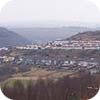
| The Valleys
The south Wales valleys are a number of industrialised valleys in South Wales. Many of them running roughly parallel to each other, they stretch from eastern Carmarthenshire in the west to western Monmouthshire in the east. Located in roughly the centre is the famous Rhondda valley.
The term "Valleys" is often incorrectly used as a synonym for Wales. As the Valleys are a closely defined area, this is wholly inaccurate.
Until the mid-nineteenth century, the south Wales valleys were lightly inhabited (as was most of Wales) and known for their natural beauty. The Industrial Revolution changed this as the valleys became important centres for both the coal mining and iron industries. Merthyr Tydfil, at the northern end of the Taff valley became Wales's largest town thanks to its growing iron works at Dowlais and Cyfarthfa.
Although iron was the first industry to develop, the valleys would become most famous for their coal mines. These attracted huge numbers of people from rural areas to the valleys. This meant that many rows of terraced housing were built along the valley sides to accommodate the influx. The coal mined in the valleys was transported south along railways and canals to ports on the Bristol Channel, notably Cardiff, Newport and Swansea. Cardiff was soon among the most important coal ports in the world andSwansea among the most important steel ports.
The Second World War marked the end of these heavy industries in the Valleys. Steel works and coal mines began to close, despite nationalisation by the UK government. In 1966, the village of Aberfan in the Taff valley suffered one of the worst disasters in Welsh history. A mine waste tip on the top of the mountain slid down the valley side and destroyed the village primary school, killing 144 people, 116 of them children.
In 1979, Margaret Thatcher became Prime Minister of the United Kingdom. Her policies of free market economics soon clashed with the loss-making, government-owned coal industry. In 1984 and 1985, after the government announced plans to close many mines across the UK, mineworkers went on strike. The ultimate failure of this strike led to the virtual destruction of the UK's coal industry. Today, the only deep coal mine left in the valleys is Tower Colliery in the Cynon Valley. This was bought by the workers in 1994, despite government attempts to close it. In the new millennium, the last of the steel industry closed, as Corus Group (formerly British Steel - now the Indian Company Tata Steel) closed its plant in Ebbw Vale.
The closure of the heavy industries led to very high unemployment in the valleys and this remains a problem today. In the 1990s, the government attracted light industries to try and reduce the level of unemployment. Many of these companies were from the Far East. However, the economy remains weak and much of the area is poor enough to qualify for European Union Objective 1 funding.
The south Wales valleys became a symbol of the whole of Wales for many foreign people (including those in the other parts of the United Kingdom). Some visitors to other parts of Wales are surprised when they do not find coal mines and terraced housing. The valleys do, however, contain a large percentage of the Welsh population and remain an important centre of Welsh culture, despite the growing domination of Cardiff. The UK parliament's first Labour Party MP, Keir Hardie was elected from the area and the Valleys remain a stronghold of Labour Party power. Rugby union is very popular and rugby pitches can be seen along the valley floors. English is the everyday language, except for the western valleys around Ammanford and the Upper Swansea valley, where Welsh is still widely spoken.
The geographical shape of the valleys have their effect on culture. Many roads stretch along valleys connecting the different settlements in the valley. Consequently the different towns in a valley are more closely associated with each other than they are with towns in the neighbouring valley, even when the towns in the neighboring valley are closer on the map. When describing where he or she come from, a valleys resident is far more like to explain in terms of which valley it is than in which borough council or unitary authority it lies. The Heads of the Valleys road, the A465 road, is significant due to its connection of valleys with each other. |






